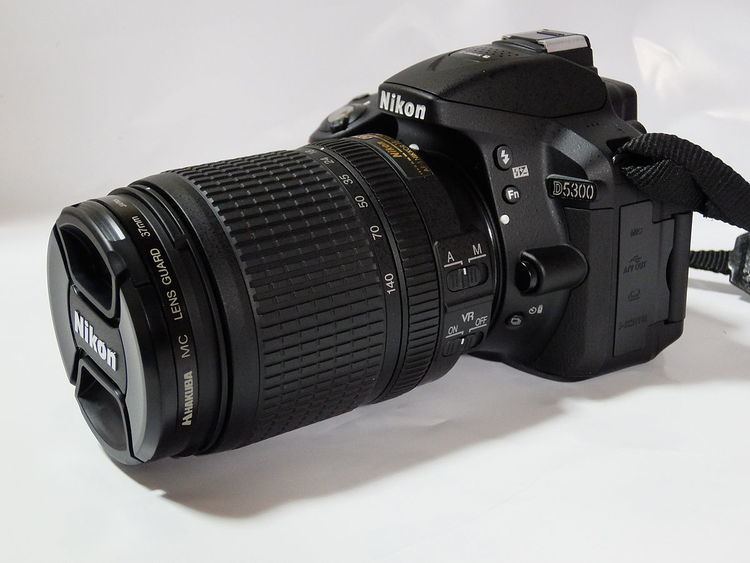The Nikon D5300 is an F-mount DSLR with a new carbon-fiber-reinforced polymer body and other new technologies, announced by Nikon on October 17, 2013.
It features the new Expeed 4 processor and is the company's first DSLR with built-in Wi-Fi and GPS. It shares the same 24-megapixel image sensor as its D5200 predecessor, but without an anti-aliasing (AA) filter, equal to the Nikon D7100. MSRP for the body is $800, and $1,400 with an 18-140mm f/3.5-5.6 kit lens.
Expeed 4 with lower power consumption; extended battery life to 600 shotsFull HD video 1080p with autofocus also in uncompressed video (clean HDMI at 60p,30p,24p only) format. Nikon's first DSLR with 60p/50p framerate at full HD resolution (several previous Nikon bodies supported 60p/50p, but only at 720p)GPS built-inWLAN (Wi-Fi) built-inAutomatic correction of lateral chromatic aberration for JPEGs. Correction-data is additionally stored in RAW-files and used by Nikon Capture NX, View NX and some other RAW tools.No Anti-aliasing (AA) filterNew pentamirror with 0.82x magnification and 95% frame coverageNine special effectsActive D-Lighting (four-level and auto).Bracketing (exposure, Active D-Lighting and white-balance).In-camera HDR mode.Inbuilt time-lapse photography intervalometerQuiet shooting mode.Built-in sensor cleaning system (vibrating low-pass filter) and airflow control system.HDMI HD video output.Enhanced built-in RAW processing with extended Retouch menu for image processing without using a computer: D-Lighting, Red-eye reduction, Trimming, Monochrome & filter effects, Color balance, Image overlay, NEF (RAW) processing, Quick retouch, Straighten, Distortion control, Fisheye, Color outline, Color sketch, Perspective control, Miniature effect, Selective Color, Edit movie, Side-by-side comparison.Stereo microphone input (has stereo built-in mic)3.2-inch (81 mm) articulated 1073k-dot vari-angle LCD.EN-EL14 or EN-EL14A Lithium-ion Battery.Slightly smaller and lighter body (480g) than its predecessorLike Nikon's other consumer level DSLRs, the D5300 has no in-body autofocus motor, and fully automatic autofocus requires one of the currently 166 lenses with an integrated autofocus motor. With any other lenses the camera's electronic rangefinder (which indicates if the subject inside the selected focus point is in focus or not) can be used to manually adjust focus.
The D5300 can mount unmodified A-lenses (also called Non-AI, Pre-AI or F-type) with support of the electronic rangefinder and without metering.

